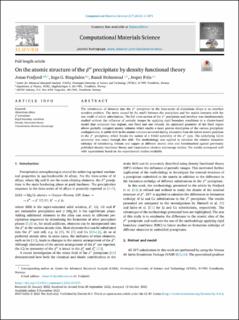| dc.contributor.author | Frafjord, Jonas | |
| dc.contributor.author | Ringdalen, Inga Gudem | |
| dc.contributor.author | Holmestad, Randi | |
| dc.contributor.author | Friis, Jesper | |
| dc.date.accessioned | 2023-10-23T12:49:35Z | |
| dc.date.available | 2023-10-23T12:49:35Z | |
| dc.date.created | 2022-12-05T15:26:26Z | |
| dc.date.issued | 2023 | |
| dc.identifier.citation | Computational Materials Science. 2023, 217, 111871. | en_US |
| dc.identifier.issn | 0927-0256 | |
| dc.identifier.uri | https://hdl.handle.net/11250/3098136 | |
| dc.description.abstract | The substitution of elements into the precipitate in the 6xxx-series of aluminium alloys is an interface sensitive problem. The strain caused by the misfit between the precipitate and the matrix interacts with the size misfit of solute substitutions. The full cross-section of the precipitate and interface was simultaneously studied without the influence of periodic images by applying rigid boundary conditions in a cluster-based model that contained two regions, one fixed and one relaxed. An optimised geometry of the fixed region allows partially occupied atomic columns which enable a more precise description of the various precipitate configurations. A subtle shift in the atomic columns occurred during relaxation from the initial atomic positions in the precipitate, which breaks the notion of a 4-fold symmetry of the eyes. The underlying C2/m symmetry was intact through this shift. The methodology was applied to calculate the relative formation enthalpy of substituting lithium and copper at different atomic sites and benchmarked against previously published density functional theory and transmission electron microscopy studies. The results correspond well with expectations based on the experimental studies available. | en_US |
| dc.language.iso | eng | en_US |
| dc.publisher | Elsevier | en_US |
| dc.rights | Navngivelse 4.0 Internasjonal | * |
| dc.rights.uri | http://creativecommons.org/licenses/by/4.0/deed.no | * |
| dc.title | On the Atomic Structure of the β′′ Precipitate by Density Functional Theory | en_US |
| dc.title.alternative | On the Atomic Structure of the β′′ Precipitate by Density Functional Theory | en_US |
| dc.type | Peer reviewed | en_US |
| dc.type | Journal article | en_US |
| dc.description.version | publishedVersion | en_US |
| dc.rights.holder | © 2022 The Author(s). Published by Elsevier. | en_US |
| dc.source.pagenumber | 5 | en_US |
| dc.source.volume | 217 | en_US |
| dc.source.journal | Computational Materials Science | en_US |
| dc.identifier.doi | 10.1016/j.commatsci.2022.111871 | |
| dc.identifier.cristin | 2088945 | |
| dc.relation.project | Norges forskningsråd: 294933 | en_US |
| dc.relation.project | Norges forskningsråd: 237885 | en_US |
| dc.relation.project | Sigma2: NN8068k | en_US |
| dc.relation.project | Norges forskningsråd: 197405 | en_US |
| dc.source.articlenumber | 111871 | en_US |
| cristin.ispublished | true | |
| cristin.fulltext | original | |
| cristin.qualitycode | 2 | |

